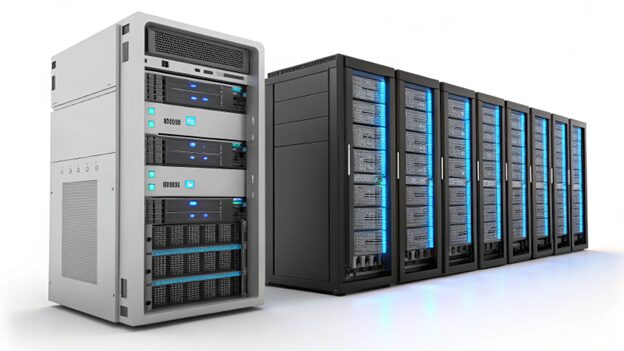RAID Technology in US Server: Guide to Data Protection

In the ever-evolving landscape of enterprise hosting solutions, RAID (Redundant Array of Independent Disks) technology stands as a cornerstone of data protection and performance optimization. For tech professionals managing US-based server infrastructures, understanding the intricacies of RAID implementations is crucial for maintaining high-availability systems and ensuring data integrity.
Understanding RAID Technology Fundamentals
It revolutionizes data storage by combining multiple physical disk drives into a single logical unit. This architectural approach serves two primary purposes: enhancing data redundancy and improving performance metrics. Before diving into complex configurations, let’s examine the core components that make RAID systems effective:
- Striping: Data distribution across multiple drives
- Mirroring: Real-time data replication
- Parity: Advanced error detection and correction
- Hot-swapping: Dynamic drive replacement capabilities
RAID Levels: Technical Deep Dive
Each RAID level presents unique characteristics optimized for specific use cases. Here’s a technical analysis of the most implemented configurations in enterprise environments:
RAID 0 (Striping)
RAID 0 implements block-level striping without parity or mirroring. This configuration offers:
- Linear performance scaling with drive addition
- 100% storage efficiency utilization
- Optimal I/O performance for sequential operations
- Zero redundancy (n=n capacity formula)
RAID 1 (Mirroring)
Critical for systems requiring fault tolerance, RAID 1 provides:
- Byte-level data mirroring across drives
- Enhanced read performance through load balancing
- Immediate failover capability
- 50% storage efficiency (n/2 capacity formula)
These fundamental configurations lay the groundwork for more complex RAID implementations. The selection of an appropriate RAID level depends on various factors, including performance requirements, redundancy needs, and cost considerations.
Advanced RAID Configurations for Enterprise Systems
RAID 5 Architecture
RAID 5 represents a sophisticated balance between performance, redundancy, and storage efficiency. The technical specifications include:
- Block-level striping with distributed parity
- N-1 storage capacity utilization
- Minimum 3 drives requirement
- Single drive fault tolerance
Performance metrics for RAID 5 configurations:
- Read Operations: (N-1) × Single Drive Speed
- Write Operations: Approximately 1/4 of RAID 0
- Rebuild Time: Proportional to drive size and array load
- Parity Calculation Overhead: ~10-15% CPU utilization
RAID 10 (1+0) Implementation
RAID 10 combines the benefits of striping and mirroring in a nested configuration, offering:
- Striped set of mirrored drives
- Multiple drive fault tolerance (within mirror sets)
- Superior write performance compared to RAID 5/6
- Faster rebuild times during drive failure
Performance Optimization Strategies
Enterprise hosting environments require careful consideration of various performance factors. Key optimization techniques include:
- Cache Configuration
- Write-back vs. Write-through policy selection
- Cache stripe size optimization
- Battery-backed cache implementation
- Drive Selection
- Enterprise-grade SSD integration
- RPM matching for array consistency
- IOPS requirement analysis
- Controller Settings
- Queue depth optimization
- Read-ahead configuration
- Stripe size alignment
Real-world Implementation Case Studies
Analysis of RAID implementations in high-demand hosting environments reveals specific patterns for optimal performance:
- E-commerce Platforms
- RAID 10 for transaction databases
- RAID 5 for content storage
- Separate arrays for logs and backups
- Media Streaming Services
- RAID 0 for temporary content caching
- RAID 6 for primary content storage
- Hot spare configuration for immediate failover
Maintenance Best Practices and Troubleshooting
Implementing a robust maintenance protocol is crucial for maintaining RAID array integrity in hosting environments. Consider these essential practices:
- Proactive Monitoring
- S.M.A.R.T. data analysis
- Performance metric tracking
- Error log review automation
- Preventive Maintenance
- Regular consistency checks
- Firmware update scheduling
- Battery backup unit testing
Troubleshooting Protocol
- Initial Assessment
- Controller status verification
- Drive health evaluation
- Performance degradation analysis
- Recovery Procedures
- Array reconstruction protocols
- Data consistency verification
- Emergency backup procedures
Emerging Trends in RAID Technology
The evolution of storage technology is reshaping traditional RAID implementations. Key developments include:
- Software-Defined RAID
- Adaptive stripe sizing
- Real-time performance optimization
- Cloud-integrated redundancy
- NVMe RAID Solutions
- Ultra-low latency configurations
- PCIe 4.0/5.0 optimization
- Distributed parity calculations
Conclusion and Implementation Guidelines
RAID technology remains fundamental to enterprise hosting solutions, with configuration choices significantly impacting system performance and reliability. When implementing RAID in US-based server environments, consider these final recommendations:
- Align RAID levels with specific workload requirements
- Implement comprehensive monitoring and maintenance protocols
- Plan for future scalability and technology evolution
- Maintain current backup strategies independent of RAID redundancy
For optimal data protection and system performance in US server hosting environments, RAID technology implementation requires careful planning, regular maintenance, and ongoing optimization. By following these guidelines and staying informed about emerging trends, technical professionals can ensure robust and efficient storage solutions for their enterprise systems.
